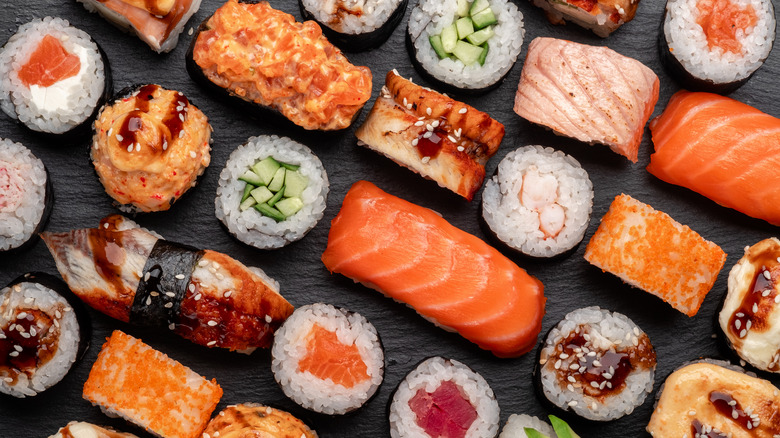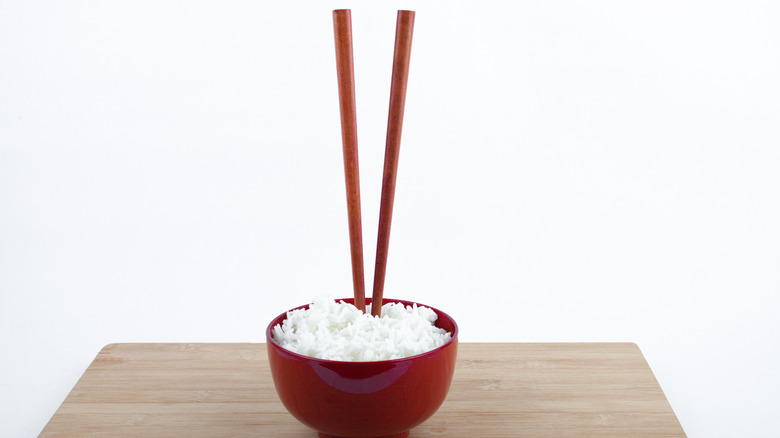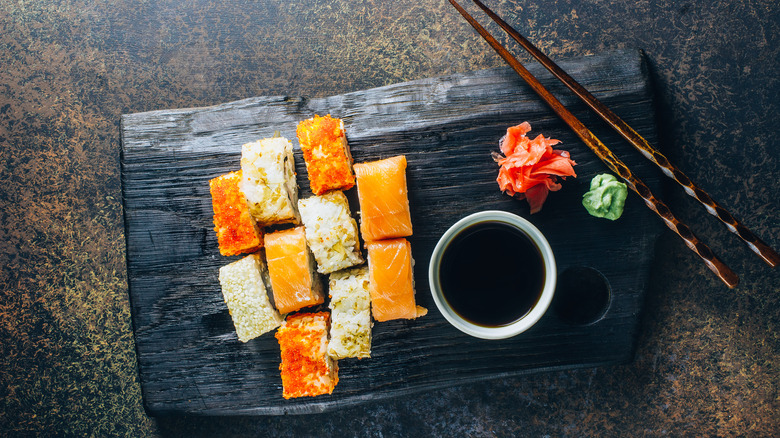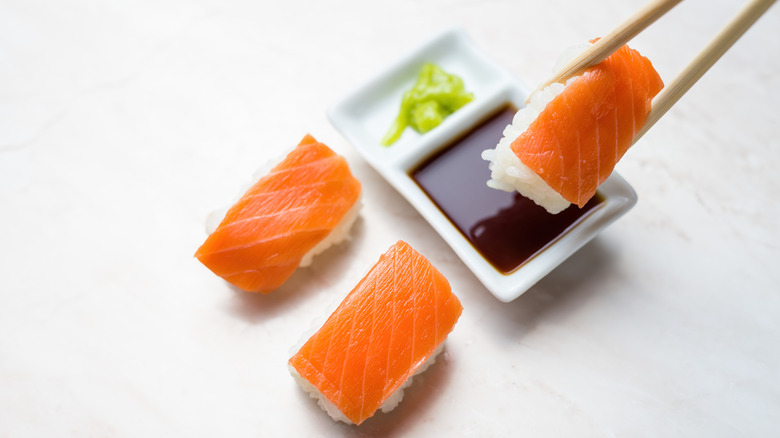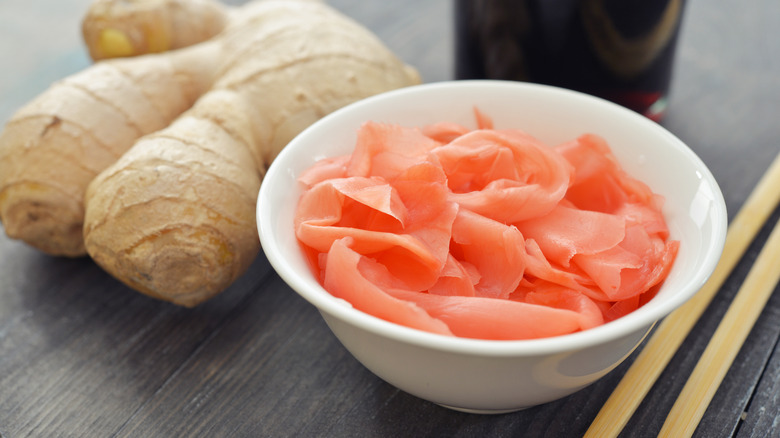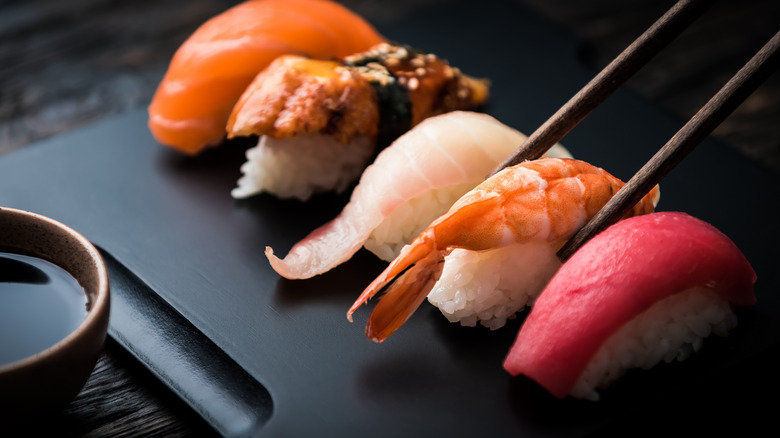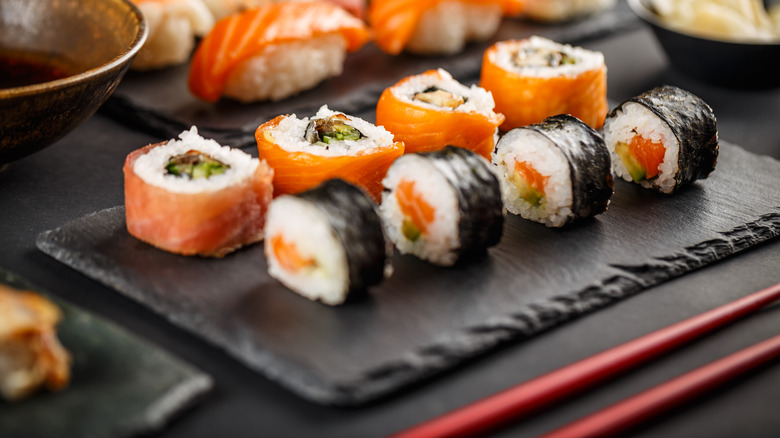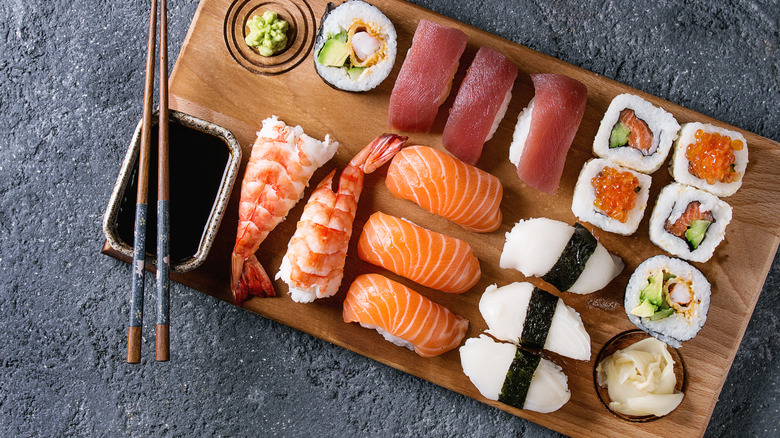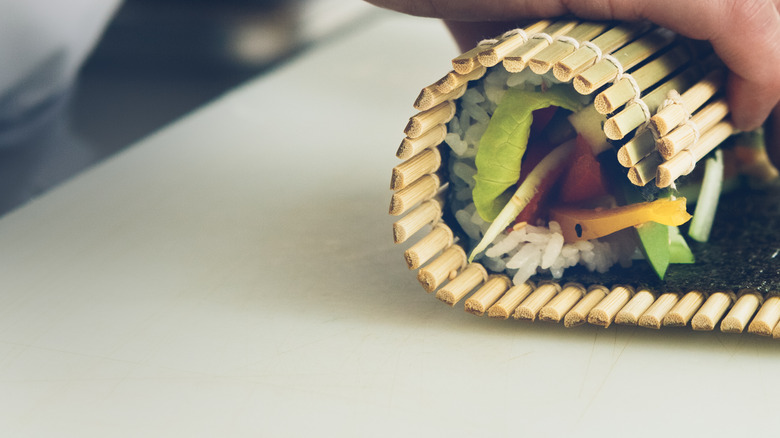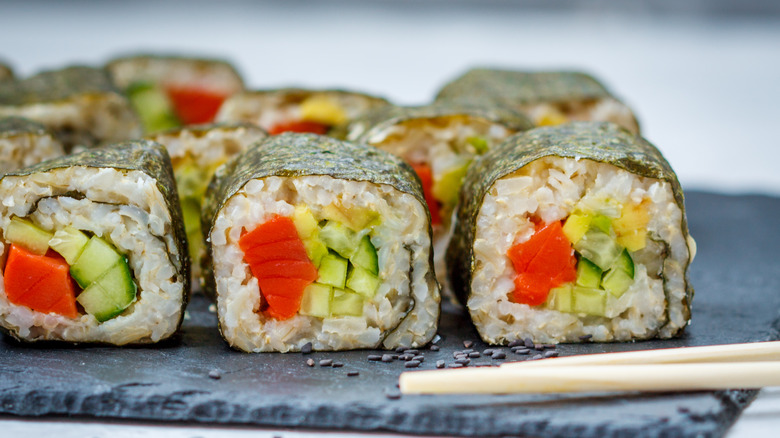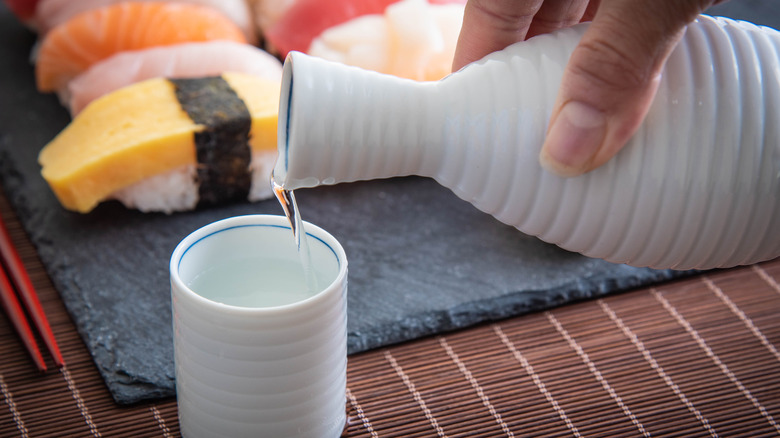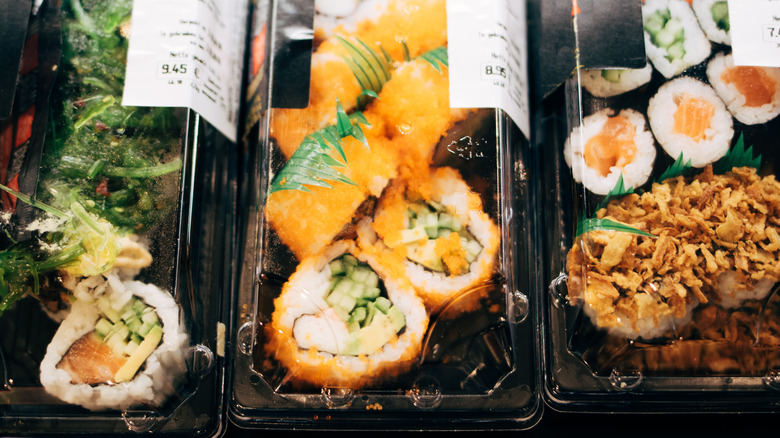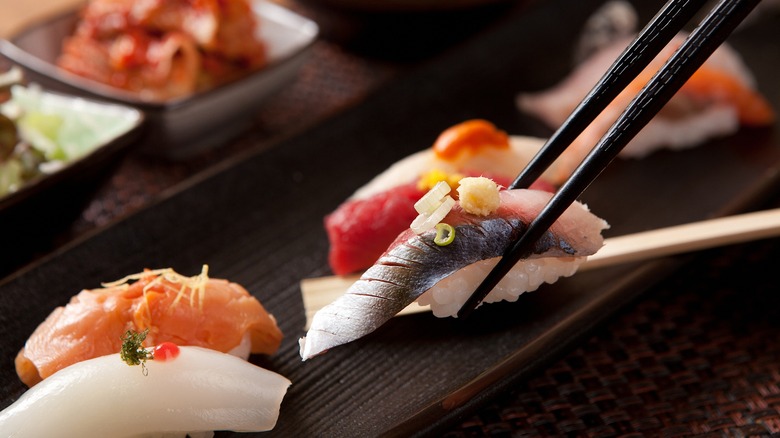You've Been Eating Sushi Wrong This Whole Time
Learning the art of sushi-making is a painstaking process. Would-be chefs must hone their knife skills so as to cut the most sublime slice of fish to ever grace your lips, and learn how to make the perfect sushi rice with the just-right balance of vinegar and salt. Maybe all that sounds simple, but it can take years to master these techniques. Given the skill and knowledge that's required to make excellent sushi, isn't it only right that we learn how to eat it properly, too?
The ins and outs of sushi etiquette are extensive, and you definitely don't want to be that person who waltzes into a sushi bar thinking you know everything there is to know about the dish and all the customs that go along with it, especially when you're likely committing one sushi-eating sin after another the moment you pick up your chopsticks. From your first soy sauce dunk to your final sake toast, there are a lot of mistakes to be made. And grocery store sushi? That's another matter altogether.
Maybe you didn't realize all the ways you're eating sushi wrong, but if you're doing any of these things, it's time to stop.
You're using your chopsticks wrong
You probably didn't realize it, but wielding a pair of chopsticks (or one single chopstick, for that matter) in the wrong way can be considered rude, unsanitary, or even invoke bad luck.
First, the worst offenders. Sticking your chopsticks upright in a bowl of rice is a bad idea. According to FluentU, this is done at Japanese funerals as an offering to the dead, and is said to bring back luck. Second, passing food from chopstick to chopstick is also symbolic of a funeral ritual, when bone fragments of the deceased are passed in this manner as they are transferred to the urn (via Japan Talk). To do so with food is considered a huge taboo.
To avoid appearing rude, you shouldn't spear food with a single chopstick, use a chopstick as a knife, place your chopsticks across a bowl or plate (unless you're finished eating), gesture or point with your chopsticks, or chew or suck on your chopsticks. For sanitary reasons, you'll also want to flip your chopsticks around to use the ends that you haven't been eating with if you're taking food from a shared dish.
And last but not least, don't insult your host by rubbing your chopsticks together. Sterling Ridings, former chef de cuisine at Uchiko, told Thrillist, "I've never gotten a splinter and I've eaten with plenty of wooden chopsticks. Don't rub your chopsticks together, it's rude. It means that you think that they get poor-quality chopsticks."
You're mixing the soy sauce and wasabi
Most wasabi lovers out there are likely guilty of this one: To get an extra kick with your sushi, you take that blob of wasabi and dump it directly into the soy sauce dish. A few stirs of the chopstick, and you've got one potent melange in that tiny bowl. We get it — you like it hot. But you're actually doing your sushi a disservice with this move.
You don't have to take our word for it — famed chef Masaharu Morimoto says this is a big sushi don't, too. "Do not put wasabi directly into your soy sauce. The sushi chef has already placed the proper amount of wasabi for the fish in nigiri," he told OpenTable. It makes sense. Why pay all that money only to destroy the delicate flavors of your sushi with an overpowering dose of wasabi? And spoiler alert: A lot of so-called wasabi is really just a mixture of horseradish, mustard, and green food coloring, so that should also make you think twice before overpowering your sauce with it.
You're overdoing the soy sauce
It's no secret that we're totally and completely addicted to salt, as Healthline notes it's a real problem in modern diets. Soy sauce, with all its glorious umami flavor, is even tastier than plain ol' salt. So why wouldn't we want to pour a bottle of it all over our sushi?
Not so fast. As sushi chef Seki Shi explained to Business Insider, "The etiquette of using soy sauce is not to ruin the balance of flavors by over dipping. Normally, chefs try to give you the perfect balance to enhance the flavors of the fish and the texture of the rice, so trust them." He advises that if you must dip a sushi roll in soy sauce, do so by dipping the nori side instead of the cut end where the rice will act as a sponge.
When it comes to nigiri, the same rules apply. Sushi chef Naomichi Yasuda laid out the sushi do's and don'ts for Munchies, where he explained that to avoid oversaturation, you should always dip the nigiri (fish) side down into the soy sauce. But he also has one more very important piece of advice: Don't shake the soy sauce off your nigiri after dipping. Yasuda likened this to — how should we put this delicately? — what a man does when he finishes his business in the men's room. Probably not the image you want to invoke at the sushi bar.
You're eating the ginger at the wrong time
Yes, that bright pink pickled ginger that's served alongside your sushi is tasty, but please stop putting it on your sushi. That's not what it's there for.
Aside from ruining the carefully crafted flavor profile of your meal, sushi chef Naomichi Yasuda explained for Munchies that putting ginger on your sushi it also rude. "Sometimes ... people pick up the ginger to put on the sushi to eat together, but this is very much bad manners," he says. As good as it is, pickled ginger is meant to be a palate cleanser, not a sushi garnish, end of story.
As Nobu Matsuhisa, owner of the one-and-only Nobu restaurants, explained how to properly eat pickled ginger in a step-by-step sushi eating video tutorial for Business Insider. According to Matsuhisa, "a piece of ginger, after one bite, if you try the next one, some tuna or shrimp or whitefish, take one piece of the ginger. Clean the salmon taste, then try the next pieces."
You're not eating it in one bite
We get it — cramming an entire piece of sushi into your mouth can prove to be a bit challenging. But it's one of those sushi-eating "do's" that you've just got to come to terms with, for a couple reasons.
According to chef Masaharu Morimoto, eating nigiri — a piece of fish pressed over a mound of rice — in one bite is the only way to "enjoy the perfect harmony of fish, rice, and wasabi. If you bite halfway, the balance will be lost" (via OpenTable). That's because the cut of fish is actually portioned out for that particular piece of sushi, and as Japan Today notes, it's important to experience all of those carefully balanced portions and flavors together at once. That's a pretty compelling reason, no?
As with many sushi-eating etiquette tips, the consequence of a wrong move isn't just a sacrifice in flavor. Often you're at risk of insulting the chef, and that's the other reason you should eat your sushi in one bite. GaijinPot Blog explains that it's rude to split a piece of sushi in half. If a piece is just too big, it's more polite to ask that the chef to please change up your portion size. This way, a smaller piece can be made with the proper balance of flavor and your chef will be much happier with youu.
You're not using your hands
You've got two options when it comes to handling sushi: chopsticks or fingers. But which do you choose? While most of us might be inclined to go right for the chopsticks, there are a few reasons why getting your hands dirty is the better way to go when it comes to nigiri.
First We Feast spoke to Trevor Corson, author of The Story of Sushi, to get the scoop on why nigiri should be eaten with your hands. He explains that doing so "allows the chef to pack the pieces of sushi together more loosely." If you're not adept at using chopsticks, attempting to pick up a loosely packed rice ball will end in disaster. Corson warns that chefs may overcorrect for this mess by overpacking the sushi. But if a chef trusts that you will handle his creation with care, he continues, "using your hands ... allows for an incredible experience where the rice falls apart and sort of mixes with the fish in your mouth."
For what it's worth, Japan Today concedes that there is no "proper" way to eat sushi, and says that there isn't a clear winner between the two. So do what feels right for you, but if you do use chopsticks for nigiri, proceed with caution.
You're not eating it fast enough
If you're splurging on an expensive dinner, you want the experience to last a couple hours, right? But a sushi dinner isn't like an antipasto platter, where you can leisurely pick at olives and cured meats for the better part of an evening and taste no difference in the quality of the food. No, a sushi dinner demands a bit more timeliness.
Sushi chef Jesse Ito told Billy Penn that diners who leave their nigiri to sit for any length of time are one of his biggest pet peeves. "Temperature control is very important," he explains, because the made-to-order rice is served at different temperatures for different menu items, and once that temperature — and therefore texture — is out of whack, all bets are off.
MasterChef finalist chef Andrew Kojima echoed the same sentiment to The Independent, saying the temperature of the rice is important to the overall flavor of the bite. "Sushi rice is meant to be warm and soft when it is freshly prepared, not cold and hard. It's warmth takes the edge off the fish (which should be in the fridge!) so that you can detect the flavor of the fish."
In other words, if you want to linger, do it in the bar before you sit down for dinner. Sushi deserves your immediate attention.
You use this word to describe the fish
As we've learned, there are plenty of ways to inadvertently insult a sushi chef, from making the wrong move with your chopsticks to dousing your nigiri in soy sauce. Another surefire way to insult a sushi chef? Using a certain word to describe the fish.
So what is this four-letter word? Well, it's actually five letters, but its impact is the same nonetheless: The word is "fishy." Even if you don't mean it negatively, it's still a nonstarter, as no chef wants to hear that particular adjective uttered in their sushi bar.
Chef Jesse Ito explains why it's such a derogatory term: "I know what people mean. A stronger flavor, or more gamey. Everyone uses it for mackerel," he tells Billy Penn. "But the word has a very negative connotation to it, for fish that's rotten or bad. My fish is as fresh as it can be. It's a huge insult."
Important reminder for your next sushi experience: Skip the mackerel — it's fishy... er, gamey.
You're ordering brown rice sushi
It's no secret that brown rice is better for you than white rice. It's a whole grain, it's got more nutrients and fiber and antioxidants, and probably some unicorn tears sprinkled in to make us all feel better about our eating habits. But all the unicorn tears in all the world still won't make brown rice sushi good.
According to NPR, there are two reasons why the whole grain just doesn't work as a sushi ingredient. For one thing — and this is a big factor — the flavor isn't compatible with other sushi ingredients. The hearty taste of brown rice can overpower the more subtle taste of the fish. Given that sushi is all about a just-right balance of flavors, you can see how earthy rice would throw things off.
Second — and this is just as important as flavor — the texture is all wrong. "Brown and long-grain rice are a disaster for sushi," explains Ole Mouritsen, biophysicist and co-author of "Mouthfeel." "Rice and fish are supposed to melt [in your mouth] together. If you're using brown rice, the fish is gone and the brown rice is still chew, chew, chew" (via NPR). If there's one thing we can all agree on, it's that sushi should definitely not be chewy.
You're drinking sake with your sushi
You belly up to the sushi bar and it's obviously time for sake bombs, right? Wrong.
Although you probably see plenty of diners sipping on sake while noshing on nigiri, it's not keeping in line with Japanese tradition. Joshua Rolnick, beverage director at NYC sushi spot Neta, told VinePair, "Traditionally in Japan, sake wasn't paired with any rice dishes. Once the rice dish hit the table, the sake went away."
The reason for skipping the sake with sushi makes a lot of sense. Rolnick says it's simply a case of "too much of a good thing." That's because sake is brewed from rice, and if you're drinking rice and eating rice, you're going to fill up too fast. So, what kind of booze is okay to drink with sushi? Beer and wine (the type that's made of grapes, not rice, naturally).
Pro tip: Whether you're toasting with sake or soda, one thing you never want to do is loudly exclaim "chin-chin!" in the middle of the sushi bar. According to Go! Go! Nihon, the proper toast is "kanpai!" which, you'll be happy to know, does not happen to be Japanese slang for many men's private parts, as chin-chin is.
You're buying grocery store sushi
When a sushi craving strikes, it's hard to ignore. The thought of that fresh, perfectly cut fish, the still-warm rice that's been seasoned just right, and the nori that crackles just slightly as you bite into it? There's nothing better. However, if you think you're going to come anywhere close to that nirvana with grocery store sushi, you've got another thing coming.
Buzzfeed asked sushi chef Yoya Takahashi to taste grocery and convenience store sushi to see how it stacked up against the real deal. Let's just say there were no rave reviews. 7-Eleven's California roll was deemed "too mushy" (one star). Trader Joe's offering had a "bad shrimp smell" and Takahashi could only manage to utter, "Wow... I literally can't say anything," after tasting it (minus zero stars — ouch).
Whole Food's sushi fared a bit better. Though he did liken the wasabi to Play-Doh, he said the sushi was "kinda pretty nice" and "kinda fresh" (two-and-a-half stars). After noticing the pink juice running out of Walgreen's fish, a sign it had been frozen, Takahashi was reluctant to try its sushi, but conceded that it was "kinda nice quality frozen tuna" but "still kinda sad" (half star).
We'll stick to a burger or a sandwich, as Takahashi suggests.
You're not abiding by Bourdain's rules
Who better to get sushi-eating advice from than Anthony Bourdain, the authority on all things food, drink, and culture? It's safe to say he picked up a few etiquette tips in his travels. Of course, as with any advice Bourdain ever dished out, it comes with some color.
According to the notoriously salty chef, there are six rules to abide by (via Food & Wine). First, thou shalt not make slurry of your wasabi and soy, or dip your sushi rice side down into that soy sauce, "unless you want to watch your rice crumble and disintegrate into an unholy mess in the wasabi slurry that you probably already made." You should also not exclaim, "This sushi is so fresh, dude."
Sushi with mayo as an ingredient? Don't even think about it. "Don't get me wrong, I love mayo," he told Food & Wine. "Tuna salad on white bread is our version of Edo-style sushi. But it belongs nowhere near raw fish." Also off the table? California rolls.
Lastly, pay attention to atmosphere if you're looking for a great sushi experience. Bourdain recommended places where "unst, unst, unst music is playing in the background, edamame comes with a cloud of dry ice." And collaboration is key, too. "A great sushi bar is like the perfect Irish pub. You make decisions with your sushi chef, with your bartender, over the course of the night, and you leave feeling extremely well cared for."
